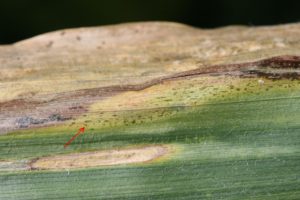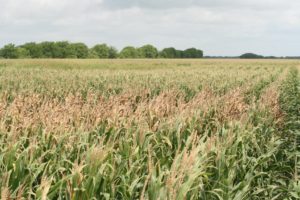by Thomas Isakeit, Professor and Extension Plant Pathologist, College Station
Goss’s wilt is a bacterial disease of corn, caused by Clavibacter michiganensis subsp. nebraskensis. In recent years, its range has expanded beyond the Midwestern states, where it had been confined for decades. Outbreaks in Texas were confirmed in 2009, 2014 and 2016. Most of the affected fields were in the High Plains, but there have been occurrences in the Blacklands and Upper Coast growing areas (Figs. 1 &2). At this point, I don’t know whether these occurrences represent a “new normal” expansion of range, or are just isolated outbreaks related to unusually wet weather in combination with planting infected seed of a susceptible hybrid. I think it will take several more seasons to know this.
It’s known that the pathogen can overwinter on crop residue under Midwestern conditions. To determine if this pathogen can overwinter in Texas, my collaborators and I placed pieces of dried, infected corn leaves collected from a Texas crop in nylon mesh bags. In September, 2016, these bags were placed either on the surface of a fallow field, or buried four inches deep. The locations were in Burleson, Hill and Fort Bend counties. The bags were recovered at approximately five week intervals and the leaf residue or adhering soil was assessed for the ability to cause disease in corn seedlings. About half the samples left on the soil surface at all locations were infective after five weeks. In comparison, samples stored dry in a refrigerator (45°F) retained infectivity. At ten weeks, the pathogen was still detectable in surface residue from all three locations. After this time, it was not detectable from the Fort Bend location. However, the pathogen was detected in about 15% of the samples from the other two locations at 25 weeks, which was in March, 2017.
In contrast, the pathogen quickly and more completely disappeared from buried samples. There was only one positive sample, detected 20 weeks after burial. The demise of the pathogen was associated with a very rapid disintegration of buried plant tissue. This pathogen does not like exposure to soil, apparently. In a separate experiment, recovery of known amounts the pathogen added to the Hill and Burleson county soils, kept at different moistures and temperatures, was measured. The pathogen survived fairly well in refrigerated soils, but at six days, the recovery was 5%-20% in soils kept at constant 72°F. At this temperature, survival plummeted dramatically after that, to 0.005%-0.009% at 32 days.
Since a small number of samples were used in these experiments, these results should be considered preliminary. However, I consider the positive detection of the pathogen in this time frame to be significant, because it shows the possibility of the pathogen bridging to the next growing season. But remember, the presence of pathogen in a field the following season does not necessarily mean that there will be a disease problem. Weather will have significant impact on disease development. Frequent rains during the growing season provide an opportunity for the pathogen to move. Significantly, the pathogen needs some wound to the plant in order to enter it, before it can cause disease. This is well known, but I have seen this in my studies. If I place millions of bacteria in water in the leaf whorl of a corn seedling, nothing happens. But if I wound the stem with a tiny needle and then place as little as ten bacteria in that wound, I will have visible disease within a week. In the field, wounds from sand blasting or hail would predispose corn to infection.
If Goss’s wilt occurred in a corn field, my current recommendation is to rotate out of corn for at least a year, and to incorporate crop residue, so that it decomposes quickly. As a precaution, grass weeds should be controlled during this period. There are reports of some grass species as additional hosts of Goss’s wilt, but their significance, particularly under Texas conditions, are not known. As an additional control measure, many corn hybrids have resistance to the pathogen. In my opinion, this disease is not likely to become a chronic problem in Texas.
If you have any questions, contact Thomas Isakeit at (979) 862-1340 or t-isakeit@tamu.edu.

Fig. 2 “Freckles” symptom of Goss’s wilt (arrow). This is a distinctive symptom for this disease. (Photo: T. Isakeit)

Thomas Isakeit, Ph.D.
Professor and Extension Plant Pathologist
College Station, TX
t-isakeit@tamu.edu
